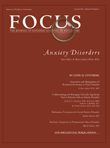Culture and the Anxiety Disorders: Recommendations for DSM-V
Abstract
Background: The anxiety disorders specified in the fourth edition, text revision, of The Diagnostic and Statistical Manual (DSM-IV-TR) are identified universally in human societies, and also show substantial cultural particularities in prevalence and symptomatology. Possible explanations for the observed epidemiological variability include lack of measurement equivalence, true differences in prevalence, and limited validity or precision of diagnostic criteria. One central question is whether, through inadvertent “over-specification” of disorders, the post-DSM-III nosology has missed related but somewhat different presentations of the same disorder because they do not exactly fit specified criteria sets. This review canvases the mental health literature for evidence of cross-cultural limitations in DSM-IV-TR anxiety disorder criteria. Methods: Searches were conducted of the mental health literature, particularly since 1994, regarding cultural or race/ethnicity-related factors that might limit the universal applicability of the diagnostic criteria for six anxiety disorders. Results: Possible mismatches between the DSM criteria and the local phenomenology of the disorder in specific cultural contexts were found for three anxiety disorders in particular. These involve the unexpectedness and 10-minute crescendo criteria in Panic Disorder; the definition of social anxiety and social reference group in Social Anxiety Disorder; and the priority given to psychological symptoms of worry in Generalized Anxiety Disorder. Limited evidence was found throughout, particularly in terms of neurobiological markers, genetic risk factors, treatment response, and other DSM-V validators that could help clarify the cross-cultural applicability of criteria. Conclusions: On the basis of the available data, options and preliminary recommendations for DSM-V are put forth that should be further evaluated and tested.
(This Article is being co-published by Depression & Anxiety and the American Psychiatric Association. This Article first appeared in Depression & Anxiety, 27:212–229 (2010).)



